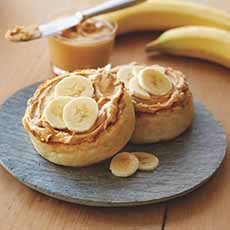TOP PICK OF THE WEEK: Wolferman’s English Muffins
|
|
If you love English muffins, you’re about to leave the realm of the perfectly fine English muffin, and step into English muffin heaven. It was created way back in 1910 by Fred Wolferman, a grocer in Kansas City, Kansas, inspired by those originated by Samuel Bath Thomas in New York City (see the history of English muffins below). Over the years, both companies expanded beyond the Original flavor, with flavors from Cinnamon Raisin to Cranberry. But Wolferman’s two-inch-high English muffins ensure that not only will the 1910 Original be an elevated experience, but there are numerous worthy flavors for you to discover: The line is certified kosher-dairy by OU. All of the flavors we’ve tried are delightful, and the Jalapeño Cheddar makes a terrific grilled cheese sandwich. But our latest flavor discovery is the Chocolate Chip English Muffin. Chocolate lovers beware: They are addictive. There are numerous gift boxes available at Wolfermans.com, and you can also buy six four-packs of most flavors. You can’t buy a single package, but you can select a mix-and-match of six flavors. Since we live solo, we can’t possibly use six packages at once (although you can freeze them). So here’s our tasting strategy: We found two other people in our apartment building who love English muffins. We split the order of six four-packs, so that each month we have two packages of the flavor—8 muffins—to try. We work in alphabetical order from the list above, so there’s no need to decide what’s next. English muffins were invented in New York City by Samuel Thomas, an emigre from England. He took the concept of the crumpet, a thinner/flatter predecessor that is covered in holes from the cooking process (photo #6). A crumpet is eaten like a single piece of toast. Thomas made a thicker version with a different cooking process that eliminated the holes, and pierced the thicker “English muffin” into two halves (here’s the history of the English muffin). But you can’t keep a good idea in just one town. The English muffin concept spread nationwide. Louis Wolferman of Kansas City, Missouri founded a corner grocery store in 1888. His slogan was “Good Things to Eat,” and he sold only the finest products. (Note that in 1888, products sold in stores were largely ingredients plus fresh-made foods like pickles, sausages and delicatessen items. The large-scale manufacture of processed foods had not yet begun—so people ate better to begin with.) In 1910, Louis Wolferman’s son Fred began to make his own English muffins, using tuna cans as molds to form and bake them. This was, and remains, an accepted way to make crumpets if one does not have crumpet rings. Just remove the top and bottom of the can and set them on the griddle or baking pan before pouring in the batter. Both Fred Wolferman and Samuel Thomas baked their muffins on a fiery open griddle. Oven baking came later. A key difference between Wolferman’s English muffins and Thomas’ is that Wolferman’s are more dense (less airy) and two inches high: hefty English muffins. The Wolferman’s brand was acquired in 1986 by Sara Lee, who purchased it from Fred Wolferman’s great-grandson. It was next acquired in 1999, by Williams Foods, who sold it in 2008 to Harry and David Holdings, where it happily remains. It’s not often that we know the historical origins of the foods we eat. Most, even those that evolved at the same time as the English muffin (like the brownie), are lost to history, legend and conjecture. As you enjoy your English muffins, raise your coffee cup or juice glass to toast Samuel, Louis and Fred, and their successful ventures in muffindom. |
|
|
|
||








